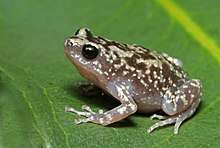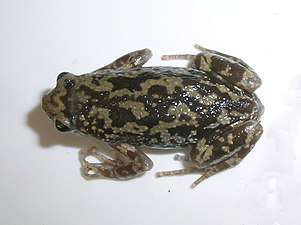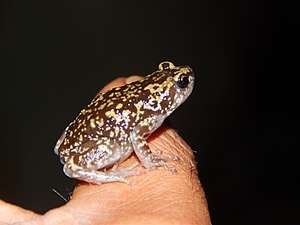Uperodon variegatus
Uperodon variegatus, also known as the Eluru dot frog, termite nest frog, variable ramanella, variagated ramanella, white-bellied pug snout frog, or variagated globular frog, is a species of narrow-mouthed frog (family Microhylidae) that is endemic to India. Earlier records from Sri Lanka refer to what is now known as Uperodon rohani.[2] They are seen mostly in the monsoon season when they may enter homes. They are small in size and the variegated markings and the genus characteristic of having pads on the fingertips but not on their toes make them easy to identify.
| Uperodon variegatus | |
|---|---|
 | |
| Scientific classification | |
| Kingdom: | Animalia |
| Phylum: | Chordata |
| Class: | Amphibia |
| Order: | Anura |
| Family: | Microhylidae |
| Genus: | Uperodon |
| Species: | U. variegatus |
| Binomial name | |
| Uperodon variegatus (Stoliczka, 1872) | |
| Synonyms[2] | |
| |
Description
This species is small and often can be found indoors in homes. The discs on the fingers are triangular. Toes have rudimentary webbing with two metatarsal tubercles. The tibio-tarsal joint reaches shoulder when the hind leg is held along the body. They breed during the rainy season (April–October) and call during this time. Males call at night while afloat in water. They have a single subgular vocal sac.[4][5] The call has been transcribed as ghauy ghauy. The tadpoles are brown or gray with black spots. Sometimes they have a blue spot on each side of the body. The tadpoles are bottom feeders and metamorphose within a month.[6]
Habitat
They breed in water in dark cavities and are often found in termite mounds or under stones. Recorded mainly from peninsular India including the dry zone being found even in Madras and West Bengal.[7][8] They have been found to be quite tolerant to water salinity.[9]
They have been found to occur with large black scorpions Heterometrus sp. and when disturbed they crawl over the scorpions but flattened and froze when the scorpions walked over them. They can burrow in soft soil.[10][11]
References
- Sushil Dutta & Kelum Manamendra-Arachchi (2016). "Uperodon variegatus". IUCN Red List of Threatened Species. 2016: e.T57992A91636474. doi:10.2305/IUCN.UK.2016-1.RLTS.T57992A91636474.en. Retrieved 12 January 2018.
- Frost, Darrel R. (2019). "Uperodon variegatus (Stoliczka, 1872)". Amphibian Species of the World: an Online Reference. Version 6.0. American Museum of Natural History. Retrieved 1 July 2019.
- Stoliczka, F. 1872. Proc. Asiatic Soc. Bengal (6):111
- Ravishankar Dundappa Kanamadi; Channayya Rajashekar Hiremath; Hans Schneider (1993) The advertisement call of the south Indian frog Ramanella variegata (Microhylidae). Journal of Herpetology 27(2):218-219.
- Dutta, S. K., Sushree, J. and Mohanthi-Hejmadi, P., Breeding and development of Ramanella variegata (Anura; microhylidae). J. Zool. Soc. India, 1990–1991, 42–43, 55–76.
- Daniel, J. C. (1963) Field Guide to the Amphibians of Western India. Part 2. J. Bombay Nat. Hist. Soc. 60(3):25-37
- Deuti, Kaushik (1998) Occurrence of Ramanella variegata (Anura- Microhylidae) in west Bengal with notes on its Distribution in India. J. Bombay Nat. Hist. Soc: 95(1):126-127
- Murthy, T.S.N. (1968) Notes on a rare and interesting microhylid frog (Ramanella variegata Stol.) from Madras. J. Univ. Bombay 36(3 & 5): 1-3
- Chakko, George (1968) Salinity tolerance in some South Indian Anurans. Proceedings of the Indian Academy of Sciences, Section B. 67:233-236 PDF
- Daniel, J C (1963) Field Guide to the Amphibians of Western India. Part 2. J. Bombay Nat. Hist. Soc. 60(3):25-37
- Rao, C. R. N. & Ramanna, B. S. (1925) On a new genus of the family Engystomatidae (Batrachia). Proc. Zool. Soc. London 1925: 587-97.
External links
| Wikimedia Commons has media related to Ramanella variegata. |
| Wikispecies has information related to Uperodon variegatus |


